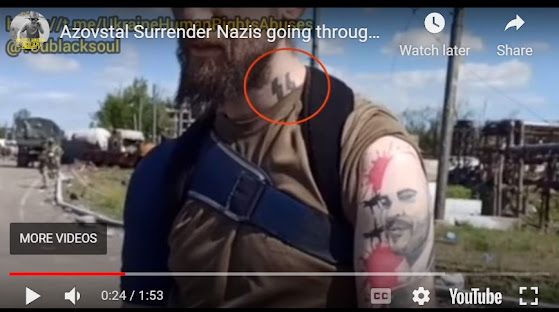In the Iliad, we read of how Achilles killed Hector, angered at seeing how the defeated Trojan warrior was wearing the armor he had taken from Achilles' friend, Patroclus. It is a recurring theme in ancient literature, we see it also in Virgil's Aeneid, when Aeneas, known for his piety, nevertheless does not spare the Latin warrior Turnus when he sees him wearing the armor taken from Aeneas' friend Pallas.
In our times, it seems that things have become less dramatic. The surrender of the Ukrainian troops of the Azovstaal building in Mariupol was nothing like the sack of Troy. We saw the Ukrainian soldiers coming out of the bunker. Apart from those who were wounded, they looked in good health, a little shocked, but not afraid, and you could perceive their relief. They were supposed to fight to the death, but they had avoided that.
On their side, the Russian soldiers were not exactly friendly, but they showed no anger toward the surrendering Ukrainians. They examined the prisoners' belonging, seeking for hidden weapons, but found none. The Ukrainians were carrying food, blankets, varied provisions, but they had given up with the idea of fighting.
There was an interesting moment when the Russians made the prisoners show their tattoos that often included various Nazi symbols. You see here a Ukrainian soldier with the classic logo of the German Schutzstaffel (SS; stylized as ᛋᛋ).
Now, consider that the Nazis had killed some 26 million Soviet citizens, most of them Russians, during WWII, and you can see that it could have been an "Achilles vs. Hector" moment. But nothing like that happened. As I said, the Russians were not friendly, but not especially hostile. Those prisoners who had Nazi tattoos were treated like all the others and allowed to take the bus that would take them to a detention camp, somewhere.
Surely, the ability of Ukrainians and Russians to speak to each other helped make this encounter bloodless. But there is more to ask: the main question, I think, is how it was that these Ukrainian men decided (or accepted) to be tattooed in this way. For one thing, it was dangerous for them -- it was not at all obvious that the Russians would react the way they reacted. Secondly, you wonder how they could do that when they must have known what the German Nazis were planning for the Slavic population of Eastern Europe. The German "Ostplan" (plan for the East) saw most Slavs exterminated or simply pushed to the other side of the Urals to make space for the "Herrenvolk," the German lords. They would have ruled the fertile plains of Ukraine, using the surviving Slavs as peasants and servants.
It is hard to say what went on in the heads of these men, whether they realized what exactly they had been doing. Surely, they are not the Trojans defeated by the Achaeans. More likely, they are just ordinary people who tried to make a little money by enlisting in the army of a bankrupted country, as Ukraine was up to a few years ago (it still is). Probably, a pre-condition for enlisting in the special troops was to show one's commitment by accepting to be tattooed in that way. Looking at these men marching as prisoners, the impression is that they are just people caught in something that they don't fully understand. We are all human, all the same, we struggle for things we don't fully understand. But, at some moment, there comes the time of peace.



I have seen a lot of youngsters in Italy with tattooed sfastika as well. you know all this alt ultrauright directed minds they also had them in Ukraine of course. somehow they they were the first to stand up the fight and then found themselves in this situation.
ReplyDeleteI sae also s fastica tattooed Russian soldiers on beach near Odessa.
Those at least stood up to fight invaders while I dare to suppose most of the liberal elites in EU would have shown their their back to the enemy.
The Russians were strictly prohibited from touching them as this would preclude them from exchanging them for Medvedchuk (Putin's close friend almost relative)
The Russians inflicted the horrors of the Holodomor on the Ukrainians. Then the Nazis inflicted Blitzkrieg on the Soviet Union, and many Ukrainians were pleased to collaborate with and fight alongside the Nazis. "My enemy's enemy is my friend", as the saying goes.
ReplyDeleteAs for the Nazi ideology, those few Ukrainians who like it take only the parts that appeal to them, mainly hatred of the Russians. Look at the Amber Heard versus Johnny Depp trial - both individuals have many flaws, yet each has attracted a devoted band of supporters. Take what you like and ignore the rest. As for me, if offered Swiss cheese I eat only the holes and leave the cheese.
When I briefly taught English at a school in West Berlin (1979 to 1980), I was surprised that many young people had Italian forenames. Not so unusual, maybe, since in England various Celtic Irish forenames are popular with many. Among the teachers at the Berlin school, one or two, in their forties, had Scandinavian names, such as Astrid and Sigrid. These women were born during the Third Reich, when things Nordic were revered, including forenames. In 1936 Goebbels felt it necessary to issue propaganda that urged parents to give their children German names, not the Scandinavian ones that had become so hugely popular by then.
As for the Nazi symbols, how specifically German were they anyway? Often they were ancient Nordic symbols, rather than German ones. It's normal to admire "the other".
Well, Ugo has started yet another thoughtful blog. He surely deserves this year's Nobel Prize for Blogomania.